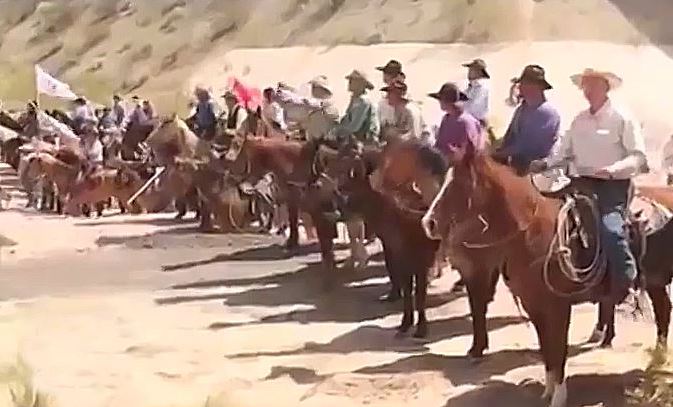An endangered fish does the unmasking.
One of the most exceptional stretches of riparian habitat in the American Southwest is under serious ecological threat. That probably does not come as a surprise to many of you. What is a surprise is that this threat comes from an environmental group.
How exceptional is this habitat? According to a recent six-year scientific study, more than 84 percent of endangered Southwestern willow flycatchers that were counted along the Cliff-Gila Valley in New Mexico were in this area. Based on that and other studies, the U.S. Fish & Wildlife Service (FWS) states that this area hosts “one of the largest flycatcher populations in the Southwest.”
Other rare species that inhabit this exceptional streamside habitat include another bird, the yellow-billed cuckoo, plus a couple of endangered fish: the spikedace and loach minnow. According to an FWS Rule of Feb. 23, 2012, which increased the level of protection for the spikedace from threatened to endangered—“This portion of the Gila River maintains a healthy stream and riparian system, and supports the largest populations of spikedace and loach minnow in the two species’ ranges.”
As exceptional as that is, what makes this situation especially mind-blowing, at least for those of us who call ourselves environmentalists, is that this unsurpassed riparian habitat is part of a functioning cattle ranch—the U Bar, owned by Freeport MacMoran Copper Company (FMC) and managed by longtime rancher David Ogilvie.
Upon hearing that, people have responded, “Better get those cows off quick and let that place return to nature before those over- grazers make all those endangered species extinct!” If that thought occurs to you, you might take comfort in learning that one environmental group is working to do exactly that. The Center for Biological Diversity (CBD) filed a notice on July 17, 2019, of its intent to sue the U.S. Forest Service for “allowing livestock to trample Southwestern rivers and streams, which destroys wildlife habitat and threatens rare species.” Among the Southwestern rivers and streams included in that “intent to sue” is the part of the Gila River in New Mexico that flows through the exceptional cattle ranch riparian area described above.

This exceptional riparian habitat is indeed under threat—but it’s from this legal action, not cattle. How can a lawsuit to remove cattle be called a threat to an exceptional riparian habitat and the endangered species that live there? Here’s how…
In the mid-1990s, two environmental groups (including the Center for Biological Diversity) filed suit against the FWS to remove livestock grazing from along nearly 900 miles of rivers and streams in the Ameri- can Southwest (including the Verde River in Arizona). As in CBD’s more recent version of the same, grazing was claimed to be a threat to a number of the threatened or endangered species that inhabited those many miles of river. With regard to the Verde, the native three-inch minnow, the spikedace, that currently inhabits the U Bar stretch of the Gila, was one of the main issues of contention.
Instead of working with the FWS to argue this suit, the U.S. Forest Service (USFS) did what one of its scientists referred to as “bowing” to environmentalists’ demands out of court and began removing grazing from public lands along many of those rivers. Interestingly, the U Bar stretch of the Gila was not included in that removal, but the Verde was. Also interestingly, during the removal of grazing from along the Verde it became apparent that the spikedace was reacting negatively to the tactic that was supposed to save it. That reaction was so negative that by 1997, when the removal of grazing was complete, the spikedace population in the portion of the Verde that had become “protected” had dropped to zero.
Commenting on this, Al Medina, one of the scientists who worked for the Rocky Mountain Research Station of the USFS and who has studied the Verde River habitat and its native fish extensively, said, “What appears to be the true reason for the demise of the spikedace in the Verde [is] that it was extirpated by policies the Forest Service adopted to satisfy the demands of a couple of environ- mental groups.” To which he added, “The number of all native fishes on the Verde has dropped precipitously since what was alleged to be the major threat to them—grazing— was removed (from 80 percent native and 20 percent nonnative to the opposite of that).”
Medina noted that the agency’s science teams were aware this was happening while the grazing removal was proceeding and sounded various alarms to that effect. On that basis, those scientists proposed studying why and how eliminating livestock grazing along the river was reducing spikedace numbers. At that point, according to Medina, the Forest Service threw those scientists “under the bus” and replaced them with “secret scientists” from a different region who presumably had less familiarity with desert fishes, and most likely didn’t ask the same embarrassing questions. More light was shed on this move when it was revealed that some of the federal staffers and scientists responsible for this under-the- bus move were involved with the environ- mental groups campaigning to remove grazing from public lands.
The outcome of this move was that pro- posed studies to examine possible negative impacts of removing cattle from the Verde riverside were rejected and only negative impacts that could be caused by not removing the cattle were considered. In other words, during the Forest Service’s bowing to CBD’s intent to sue, the possibility that grazing could possibly benefit any endangered species, spikedace or otherwise, was treated as too absurd to even acknowledge, let alone study. The USFS thus continued its study while wearing self-imposed secret-scientist blinders. However—and it’s a big however—on the
U Bar and the Gila, the FWS stated that it had not included significant portions of the Gila River and its tributaries in the critical habitat designation and grazing removal because “the management plans [of FMC and the U Bar] provide benefits to spikedace and loach min- now that are equivalent to those that would be provided by critical habitat designation [and grazing removal].”
What brought it to this conclusion? Refer- ring back to the 2012 FWS Rule, this portion of the Gila River, as managed (grazed), “sup- ports the largest populations of spikedace and loach minnow in the two species’ ranges.”
What this exclusion of the U Bar from bowing to CBD’s first lawsuit to remove grazing does is provide a promising opportunity to inject accountability into our society and its agencies’ efforts to deal with issues like endangered species and habitat sustainability. In other words, it provides the opportunity to do what the Forest Service refused to do in its efforts to sustain endangered species’ habitat on the Verde: to examine possible negative impacts of removing cattle from the riversides and to consider the positive effects of continuing to graze.


What makes the management of the U Bar so effective, so “at home” to species like the spikedace and Southwestern willow fly- catcher? David Ogilvie manages the U Bar’s cattle to enhance and sustain ecosystem health via practices similar to those discovered, analyzed, and instructed by Allan Savory (“Cows Can Save the World,” RANGE, Summer 2015). Ogilvie herds cattle as apex predators herd their prey animals—as, for instance, wolves, reintroduced into Yellowstone in 1995, are now doing with the elk there— herding and bunching them and keeping them moving so they don’t park and over- graze. That application of Savory’s principles, applied by wolves rather than humans, has been one of the most celebrated successes we humans have taken part in to heal and sustain nature in recent times. In fact, it is even celebrated by CBD along with a long list of other environmental groups.
Actually, these practices were in use by humans well before Savory began advocating them in the 1970s. Native Americans herded bison. African natives herded wildebeest. Not far from the Verde, on a tributary bordered by steep cliffs, there is a petroglyph showing Native American hunters providing the apex- predator function by herding bighorn sheep over a cliff—a bighorn jump. In other words, what CBD removed from the Verde ecosystem, and intends to remove from other ecosystems by halting human herding of grazing animals, is not an alien process imported by recently arrived cowboys but an ecosystem interaction that dates back hundreds, in some cases thousands, of years.

All this brings us to an obvious question: If one of CBD’s main goals is to keep threatened and endangered species such as the spikedace, the Southwestern willow flycatcher, yellow-billed cuckoo, loach minnow and others from going extinct, and one of its main efforts in achieving that goal failed as notably as it did on the Verde, why hasn’t the organization approached FMC and Mr. Ogilvie and asked, “What are you doing that works so well, and what can we do to help?”

Why has CBD instead announced an intent to sue which, if it achieves its goal, would halt grazing along the Gila on the U Bar and end the management which is sustaining such superlative numbers of the very species the group claims matter so much to it? Shedding more revealing light on CBD’s new intent to sue is that it does not mention the spikedace in the list of species it would protect. The fact that significant numbers of this endangered fish inhabit areas (including the U Bar) which would be affected by this move make that exclusion curious, to say the least. The best explanation might be that mentioning the spikedace in this new intent to sue would provide the opportunity for opponents to ask: “If this same action eliminated the endangered species it was supposed to protect on the Verde, why are you suing to apply it in other places? And what about the other threatened and endangered species that it would impact? What have you got against them?”
Dan Dagget, selected by the Sierra Club as one of 100 Environmental Heroes on the occasion of the group’s centennial celebration, awakened, via his activism, to the importance of humans interacting with herd animals via ranching and wrote two highly acclaimed books: “Beyond the Rangeland Conflict, Toward a West That Works” and “Gardeners of Eden, Rediscovering Our Importance To Nature.”
Check the posts on his website at http://www.dandagget.com/




I’d add some sheep grazing also to graze the same range With cattle.
Adding sheep harvests different graze and browse than cattle thus is thee Best of land management practices.
Grazing land Saves All Environments.
That simple.